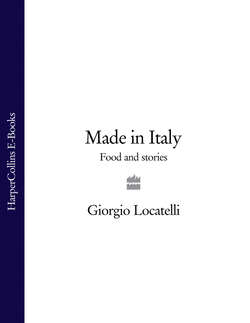Читать книгу Made in Italy: Food and Stories - Giorgio Locatelli - Страница 65
Salumi Cured meats
Оглавление‘The voice of the people’
I am a great believer in the idea that – as much as art or literature or poetry – cured meats are truly representative of the cultural background of society; they are the voice of the people, and have been over hundreds of years. You have to remember that Italy was traditionally an agricultural country; so at one time most families would have kept a pig and used every part of it. In our region a typical dish was cazzola, made with a whole pig’s head, trotters and ribs, and Savoy cabbage. What wasn’t eaten fresh would be cured to feed the family for the next year. In every larder there would have been hams and salame hanging from hooks in the ceiling, each representing the taste, produce and microclimate – the real rural roots – of a particular community. In some villages, on the feast of St Anthony Abate, they still run a lottery to win a pig which runs around the village for a year before being slaughtered to feed the winning family.
In the Northeast around Trentino-Alto Adige, where it is more rainy and often cold, you are not going to cure anything in salt alone as easily as in Parma, so you tend to have salumi that is also lightly smoked, such as speck (smoked prosciutto). Or you first marinate the meat in wine to speed the curing process, as in bresaola, the speciality of Valtellina, in my region of Lombardia. Though the majority of salumi is made with pork, in Northern Lombardia we have more cattle than pigs, so the bresaola is made with beef, first marinated in red wine, and then air-dried. Sometimes, too, they make bresaola with horse meat or venison. And in the mountains, the leg of a kid goat is often cured, like a ham (violino di capra), or made into salami.
In Colonnata in the mountains above Carrara in the Northwest of Toscana, they traditionally make lardo, which is hard pig fat from under the skin of the animal’s back, covered with salt, garlic, peppercorns, spices and herbs like rosemary, then matured in a closed container for six months, so that the oils in the seasoning impregnate the snowy white fat. (In ancient times, it was packed in tubs made using marble from the local mines, and known as ‘white marble’.) Unpromising as it might sound, lardo is beautiful when sliced very thinly and served on toasted bread.
Never underestimate how local such foods still are in many parts of Italy – even though you might see a selection from every region in an Italian deli in London. In Bologna, for example, they make the famous mortadella, the biggest of Italian sausages, which is steamed or poached, rather than cured, and has a texture so fine it is almost a paste. It is made with pork, but sometimes with beef added, together with spices, and often pistachio nuts, coriander seeds, wine and sugar. I remember talking to a guy I met in the army, about how we used to go into Bologna and have a focaccia with mortadella, and he said he had never had mortadella, because he came from Napoli.
